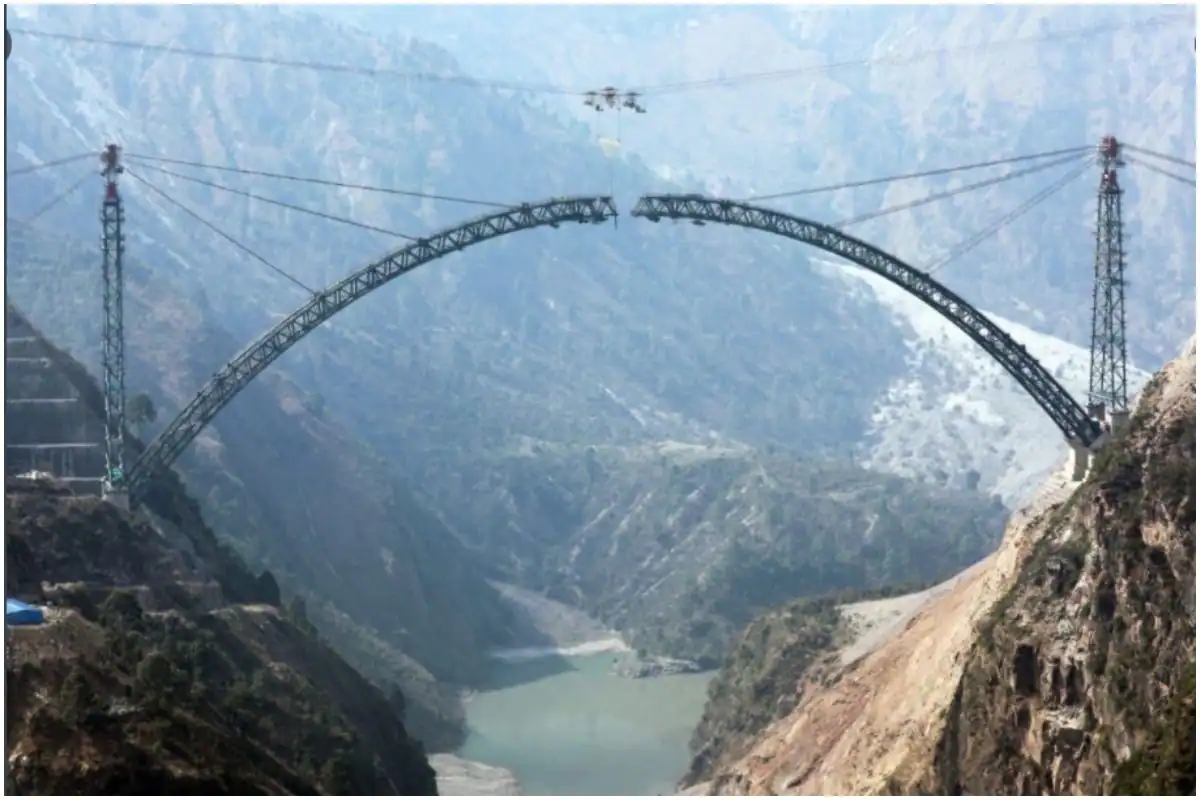In the middle of the mighty Himalayas in Indian-administered Kashmir lies the world’s highest railway bridge.
The bridge over the Chenab River – 1,315-metre-long (4,314 feet) and 359-metre-high (1,177 feet) from the bed of the river – will link the remote region with India’s vast railway network by providing all-weather connectivity.
At the peak of the winter, a large part of the disputed region is cut off from the rest of India.
The bridge, taller than the Eiffel Tower in Paris, lies between the villages of Bakkal and Kauri in Reasi district of the southern Jammu area of Kashmir.
Constructed at a cost of $168m, the bridge is part of the Udhampur-Srinagar-Baramulla Rail Link project (USBRL), which will connect the region’s main city of Srinagar with mainland India through rail networks on which work started in 1999.
Engineering marvel
The arch bridge, made of 28,000 tonnes of steel, is considered an engineering marvel as it is built in an area prone to high seismic activity. The rough and uneven terrain also sees frequent landslides and harsh weather conditions.
The 119km-long (73 miles) railway project comprises 38 tunnels and 931 bridges having a combined length of 13km (8 miles) to make the railway link possible.
Prior to its construction, the engineers had to make a 26km (19 miles) approach road and a 400-metre-long (1,300 feet) tunnel to reach the site of the bridge.
While inspecting the completion of the bridge last month, Ashwini Vaishnaw, India’s railway minister, conceded that it was the most difficult engineering challenge for the department.
“This bridge and the other tunnels were difficult because this whole area is highly seismic prone area. To strengthen it from any seismic activity special strengthening technology has been used,” the minister said.
Misgivings over the much-delayed project were addressed when the minister said the railway connectivity to Srinagar will be completed by December this year or January next year.
The bridge, official documents say, has been built to withstand strong winds and high-magnitude earthquakes.
It took two decades for thousands of workers and hundreds of engineers to complete the feat.
“This project has been the most daunting work undertaken by post-independence Indian Railways,” an engineer working on the project told Al Jazeera.
He did not disclose his name as he was not authorised to speak to the media.
“The completion of the bridge also shows vast advancement in India’s engineering technology,” he added.
Long-awaited connectivity
There is no direct rail link between the Kashmir Valley and mainland India.
The current railway line running through the valley carries local passengers from the region’s Baramulla district in the north to Banihal in Ramban district of the Jammu area.
The new rail bridge will connect Kashmir Valley with Katra in Jammu, reducing the journey time by five to six hours from Katra to Srinagar.
It is therefore a crucial part of the Indian Railways project to connect the valley with the rest of India, which is so far dependent on road networks.
The Srinagar-Jammu highway which is the only road connectivity between Kashmir and mainland India is often blocked due to heavy snowfall during winters, landslides and avalanches. Traffic on the route gets stuck for days, making people and trade suffer.
The treacherous road prone to accidents has also claimed many lives. Last year, at least 648 road accidents took place on the road, leading to 93 deaths, according to the data from the federal Ministry of Road Transport and Highways.
Local residents say that people from different parts of India visit the site to see the bridge.
“This bridge gave employment to many locals who worked there for years. It has become a tourist spot,” Gulzar Khan, 36, a resident of Khurru village in Reasi, told Al Jazeera.
Javed Ahmad Tenga, head of the Kashmir Chamber of Commerce and Industries (KCCI), a union of traders in the region, told Al Jazeera the rail connectivity will propel the region’s trade.
“The charges of transportation of goods will reduce. This will benefit the business community. By road, it takes a lot of time for things to reach here. It will strengthen the fruit business as well,” Tenga said.
Local apprehensions
However, many Kashmiris fear the train connectivity would assimilate the disputed region further into mainland India. They fear the project would affect the demography of India’s only Muslim-majority region.
The fears stem from the 2019 abrogation of Kashmir’s limited autonomy by the Hindu nationalist government of Prime Minister Narendra Modi and bringing it under New Delhi’s direct control.
Among the many changes the move brought was allowing non-Kashmiris to permanently settle in the region and start businesses.
“This railway will facilitate connectivity but we are also worried that there will be a rush of non-locals to the region. Anyone who wants to come here will board the train,” said Khursheed Ahmad, a resident of Srinagar.
Last month, the government told the parliament that 185 non-locals had bought land in Kashmir while 1,559 companies had invested in the region.
In 2020, only one non-local had bought land in the region, according to government data.
Being one of the most militarised regions in the world, enhanced railway connectivity will also transform the security scenario with easy mobilisation of supplies, troops and equipment.
“The train will help in bringing logistics and stocks for the army to Kashmir,” DS Hooda, former northern commander of the Indian Army, told Al Jazeera.
Kashmiri academic and political analyst Siddiq Wahid said the railway connectivity would mean greater control over the region.
“This will help economically no doubt. Certainly, ecologically trains are better than roads. Connectivity will be a huge assistance to New Delhi in terms of control. I think that is their ambition

